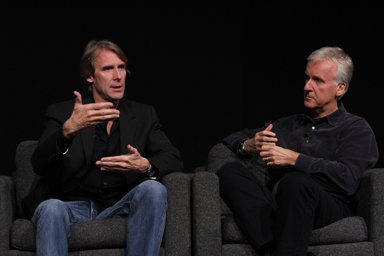
- Industry
The state of 3-D according to James Cameron and Michael Bay
15 minutes of footage from the upcoming Michael Bay's Transformers: Dark of the Moon were shown to a few members of the HFPA, along with some domestic journalists, film students and special effects experts. Produced by Steven Spielberg, the third Transformers episode will be released on June 29th, 2011. Shia LaBeouf is back in the role of Sam Witwicky, while English super-model Rosie Huntington-Whiteley, in her acting debut, replaces Megan Fox as Sam's new love interest. Back in the futuristic action saga will also be Josh Duhamel, Tyrese Gibson and John Turturro.
The preview of Trans 3 was held at Paramount Studios, in a fully packed screening room. The movie opens with archive images of Apollo 11 moon landing converted impressively in 3-D, providing us with a brand new look at an historic event. The special presentation was followed by a talk about the state of 3-D in film, moderated by Hollywood Reporter's Jay Fernandez, with technology pioneer James Cameron and Bay. The two directors explained the difficulties of filming in 3-D, and yet illustrated the "new toy" with contagious enthusiasm. Bay said he was initially reluctant to jump on the 3-D bandwagon, considering himself an old-school director in love with 35mm. He likes to shoot fast, he said, and feared 3-D would slow his pace. He "converted" to tridimensional cameras after a visit on the set of Cameron's Avatar. “I fell in love with 3-D very quickly”, he said. "As a director I always try to come up with something new to entertain the audience. I felt that 3-D was the natural next step for me. It gave me the opportunity to improve my urban action sequences and provide further thrill through the anamorphic glasses. Filming in 3-D comes inevitably with new challenges, like toning up and down the 3-D perspective depending on the speed of the images."
The main problem of 3-D filming, Cameron said referring to his own Avatar, was the special cameras' heaviness. "The 3-D cameras I used for Avatar weighed 28 pounds; considering that I was shooting every single scene with two or three of them at a time, it's easy to understand the burden we all carried in that predicament," Cameron explained. "But that was the past. Today we have the Alexa M 3-D camera, which weighs only 5 pounds and it's way easier to handle than its predecessors." Bay talked at length about the ways 3-D gives film directors a chance to explore their most imaginative side, while also underlining the demand the new technology brings in "showing something that’s not there while filming, something you always have to keep in mind, if you want to lead the audience's eyes," Bay said. This explains, he continued, why many film directors are throwing themselves headlong into this new challenge, from Martin Scorsese to Baz Luhrmann and, as recently announced, Bernardo Bertolucci, who will film his new movie in 3-D. Cameron and Bay didn’t shy away from discussing the impact the increased cost of the 3D technology has on a film, an average of 30 million dollars more. “But how much more box office will it bring in?” Cameron quips. “With 3D you usually cash in a lot more! The danger, now that we found the way to bring audiences back to the cinema and the big screen, is the abuse of that technology, with little respect for the audience or the technology. 3D is here to stay, but you can turn people off from 3D with an epidemic of poor quality productions simply trying to monetize its novelty. Not all movies are meant to be in 3D.” But that’s not the only obstacle. “Many theaters also lack the technical support to project the films as they are meant to be projected, ruining the experience for the public,” Cameron declared. “We, as an audience and filmmaker community, have to put pressure on theaters,” he concluded, greeted by a huge applause.

